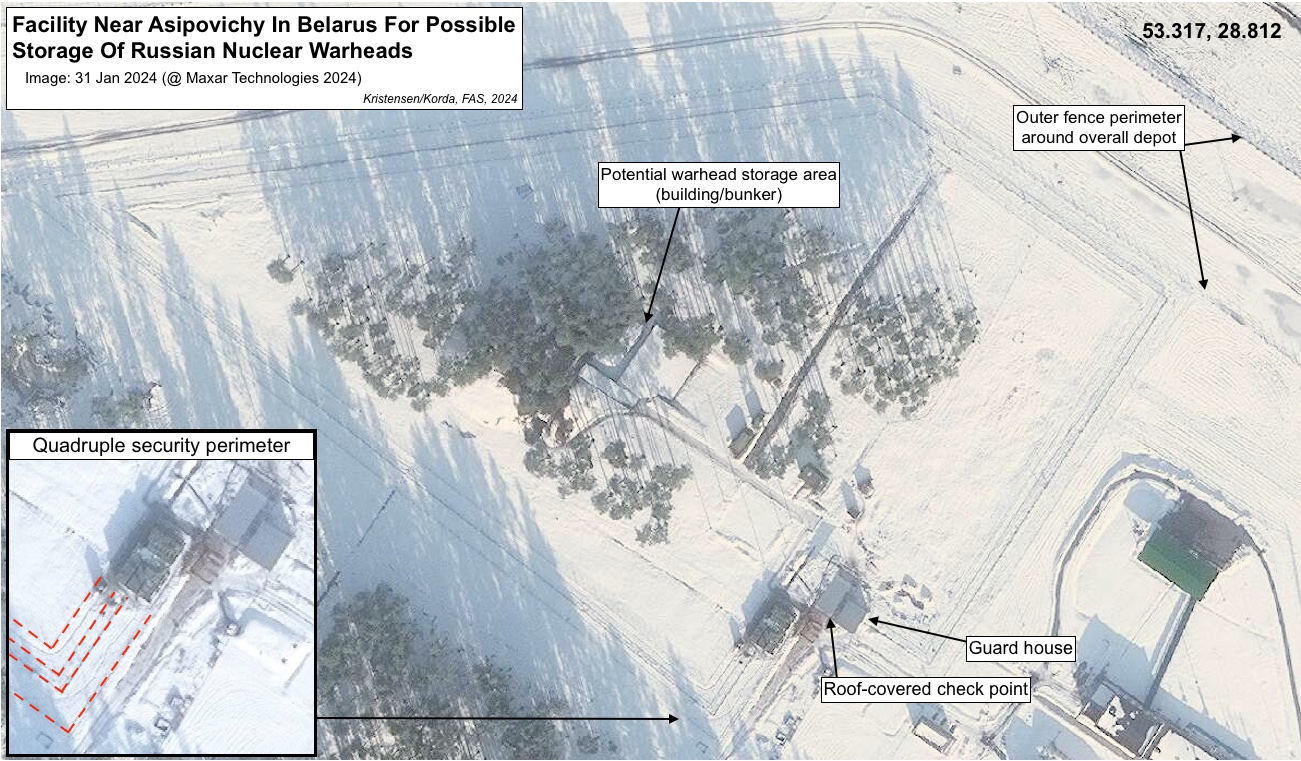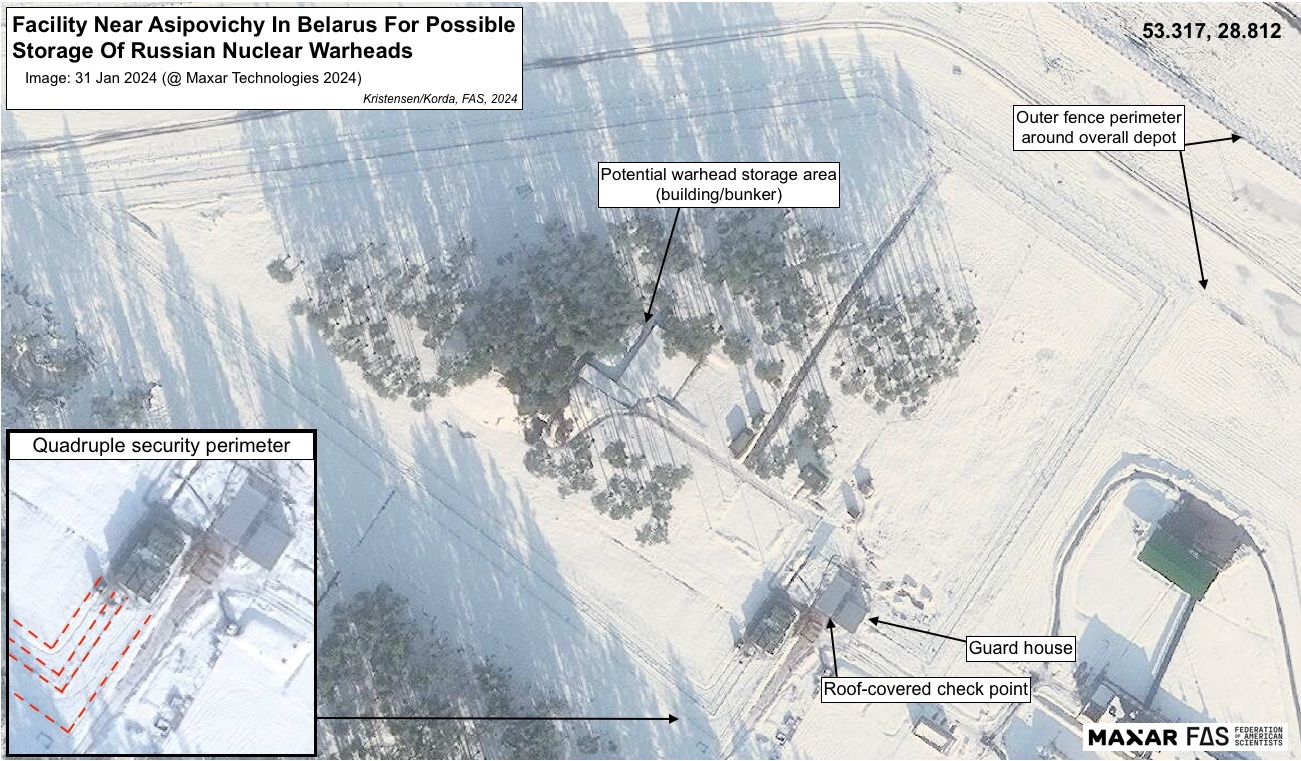
Depot In Belarus Shows New Upgrades Possibly For Russian Nuclear Warhead Storage
A military depot in central Belarus has recently been upgraded with additional security perimeters and an access point that indicate it could be intended for housing Russian nuclear warheads for Belarus’ Russia-supplied Iskander missile launchers.
The upgraded enclosure is located inside an existing military depot east of the town of Ashipovichy. Leaked documents on Discord indicated that in February 2023, the CIA reported that “a senior officer from the Russian Ministry of Defense inspected a facility in the vicinity of Asipivochy [sic] for potential upgrades” to serve as “a nuclear warhead storage facility in Belarus” (see excerpt of CIA leaked report below).

This part of a leaked CIA document reported Russian inspection of Asipovichy for potential nuclear warhead storage.
A satellite image provided by Maxar Technologies shows that part of the depot near Asipovichy has since been upgraded with a quadruple-fence security perimeter and a roof-covered guarded access point (see image below).

Upgrades to Asipovichy depot now shows quadruple security perimeter.
Satellite images show that construction began at the facility around the time of the reported visit by the senior Russian official. The upgrades have progressed slowly, with the initial construction of a double-layer security perimeter. That would be insufficient for storage of nuclear warheads. In October 2023 construction of a new perimeter began inside the existing security perimeter, and the Maxar image from late-January 2024 shows what appears to be a total of four security perimeters. The construction of the added perimeters shows significant digging for what could potentially be cables and various sensors. Trees within the new inner perimeter have also been cleared by approximately 20 meters away from the fencing.
If so, these upgrades would more closely resemble the level of physical protection that Russian authorities would require for storage of nuclear weapons.
Russian and Belarusian statements over the past two years have repeatedly claimed that nuclear weapons had been brought to Belarus, but we had previously not seen clear evidence that facilities had been readied for that purpose.
Earlier today, under the headline “Russian Nuclear Weapons Are Now In Belarus,” Foreign Policy reported that “Western officials,” including the Lithuanian defense minister, “confirmed the news of the deployment.” The article says that “a senior Lithuanian diplomat and other Western officials indicated to Foreign Policy that Russia had built specific storage facilities and railway systems in Belarus to potentially house a nuclear arsenal.”
It remains unclear if the confirmations referred to nuclear-capable launchers or the actual warheads for those launchers. But the upgrade at the Asipovichy depot shows security features that potentially could match upgrades required for nuclear warhead storage at the same facility that the Russian defense official apparently inspected one year ago.
If nuclear warheads have indeed been moved to Belarus, it does not give Russia a significant military advantage in eastern Europe. Russia already maintains modernized nuclear storage facilities in Kaliningrad and has long had the ability to target NATO countries with nuclear weapons. Instead, the deployment appears designed to unnerve NATO’s eastern-most member states and highlight Russia’s status as a nuclear power.
Additional background information:
• Nuclear Weapons Sharing, 2023
• Belarus “Nuclear-Capable” Iskanders Get A New Garage
• Russian Nuclear Weapons Deployment Plans In Belarus: Is There Visual Confirmation?
• Russian Nuclear Weapons In Belarus? A CNS Roundtable Discussion
• Video Indicates That Lida Air Base Might Get Russian “Nuclear Sharing” Mission In Belarus
• Geo-Location of Russian-Supplied Iskander Launchers Training at Osipovichi i Belarus
This research was carried out with generous contributions from the the New-Land Foundation, Ploughshares Fund, the Prospect Hill Foundation, Longview Philanthropy, and individual donors.
The FY2026 National Defense Authorization Act (NDAA) paints a picture of a Congress that is working to both protect and accelerate nuclear modernization programs while simultaneously lacking trust in the Pentagon and the Department of Energy to execute them.
While advanced Chinese language proficiency and cultural familiarity remain irreplaceable skills, they are neither necessary nor sufficient for successful open-source analysis on China’s nuclear forces.
Satellite imagery has long served as a tool for observing on-the-ground activity worldwide, and offers especially valuable insights into the operation, development, and physical features related to nuclear technology.
This report outlines a framework relying on “Cooperative Technical Means” for effective arms control verification based on remote sensing, avoiding on-site inspections but maintaining a level of transparency that allows for immediate detection of changes in nuclear posture or a significant build-up above agreed limits.